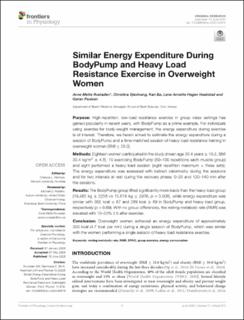| dc.contributor.author | Rustaden, Anne Mette | |
| dc.contributor.author | Gjestvang, Christina | |
| dc.contributor.author | Bø, Kari | |
| dc.contributor.author | Haakstad, Lene Annette Hagen | |
| dc.contributor.author | Paulsen, Gøran | |
| dc.date.accessioned | 2020-07-10T06:52:25Z | |
| dc.date.available | 2020-07-10T06:52:25Z | |
| dc.date.created | 2020-04-28T15:31:33Z | |
| dc.date.issued | 2020 | |
| dc.identifier.citation | Frontiers in Physiology. 2020, 11, Artikkel 570. | en_US |
| dc.identifier.issn | 1664-042X | |
| dc.identifier.uri | https://hdl.handle.net/11250/2663642 | |
| dc.description | This is an open-access article distributed under the terms of the Creative Commons Attribution License (CC BY) - http://creativecommons.org/licenses/by/4.0/. The use, distribution or reproduction in other forums is permitted, provided the original author(s) and the copyright owner(s) are credited and that the original publication in this journal is cited, in accordance with accepted academic practice. No use, distribution or reproduction is permitted which does not comply with these terms. | en_US |
| dc.description.abstract | Purpose: High-repetition, low-load resistance exercise in group class settings has gained popularity in recent years, with BodyPump as a prime example. For individuals using exercise for body-weight management, the energy expenditure during exercise is of interest. Therefore, we herein aimed to estimate the energy expenditure during a session of BodyPump and a time-matched session of heavy load resistance training in overweight women (BMI ≥ 25.0). Methods: Eighteen women participated in the study (mean age 35.4 years ± 10.2, BMI 30.4 kg/m2 ± 4.8), 10 exercising BodyPump (50–100 repetitions each muscle group) and eight performed a heavy load session (eight repetition maximum × three sets). The energy expenditure was assessed with indirect calorimetry during the sessions and for two intervals at rest during the recovery phase: 0–20 and 120–140 min after the sessions. Results: The BodyPump group lifted significantly more loads than the heavy load group (19,485 kg ± 2258 vs 15,616 kg ± 2976, p = 0.006), while energy expenditure was similar with 302 kcal ± 67 and 289 kcal ± 69 in BodyPump and heavy load group, respectively (p = 0.69). With no group differences, the resting metabolic rate (RMR) was elevated with 15–22% 2 h after exercise. Conclusion: Overweight women achieved an energy expenditure of approximately 300 kcal (4.7 kcal per min) during a single session of BodyPump, which was similar with the women performing a single session of heavy load resistance exercise. | en_US |
| dc.language.iso | eng | en_US |
| dc.subject | EPOC | en_US |
| dc.subject | RMR | en_US |
| dc.subject | energy consumption | en_US |
| dc.subject | group exercise | en_US |
| dc.subject | resting metabolic rate | en_US |
| dc.title | Similar energy expenditure during BodyPump and heavy load resistance exercise in overweight women | en_US |
| dc.type | Peer reviewed | en_US |
| dc.type | Journal article | en_US |
| dc.description.version | publishedVersion | en_US |
| dc.rights.holder | © 2020 Rustaden, Gjestvang, Bø, Haakstad and Paulsen. | en_US |
| dc.source.pagenumber | 8 | en_US |
| dc.source.volume | 11 | en_US |
| dc.source.journal | Frontiers in Physiology | en_US |
| dc.identifier.doi | 10.3389/fphys.2020.00570 | |
| dc.identifier.cristin | 1808497 | |
| dc.description.localcode | Institutt for idrettsmedisinske fag / Department of Sports Medicine | en_US |
| cristin.ispublished | true | |
| cristin.fulltext | original | |
| cristin.qualitycode | 1 | |
